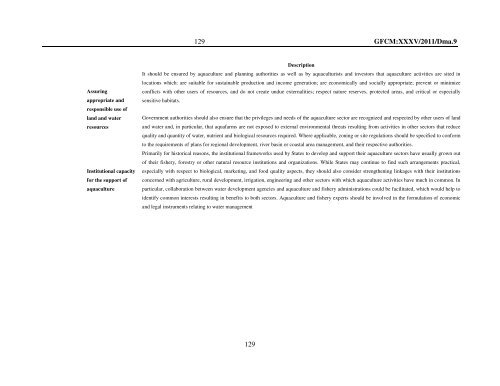Site selection and carrying capacity in Mediterranean ... - FAO Sipam
Site selection and carrying capacity in Mediterranean ... - FAO Sipam
Site selection and carrying capacity in Mediterranean ... - FAO Sipam
You also want an ePaper? Increase the reach of your titles
YUMPU automatically turns print PDFs into web optimized ePapers that Google loves.
Assur<strong>in</strong>g<br />
appropriate <strong>and</strong><br />
responsible use of<br />
l<strong>and</strong> <strong>and</strong> water<br />
resources<br />
Institutional <strong>capacity</strong><br />
for the support of<br />
aquaculture<br />
129 GFCM:XXXV/2011/Dma.9<br />
129<br />
Description<br />
It should be ensured by aquaculture <strong>and</strong> plann<strong>in</strong>g authorities as well as by aquaculturists <strong>and</strong> <strong>in</strong>vestors that aquaculture activities are sited <strong>in</strong><br />
locations which: are suitable for susta<strong>in</strong>able production <strong>and</strong> <strong>in</strong>come generation; are economically <strong>and</strong> socially appropriate; prevent or m<strong>in</strong>imize<br />
conflicts with other users of resources, <strong>and</strong> do not create undue externalities; respect nature reserves, protected areas, <strong>and</strong> critical or especially<br />
sensitive habitats.<br />
Government authorities should also ensure that the privileges <strong>and</strong> needs of the aquaculture sector are recognized <strong>and</strong> respected by other users of l<strong>and</strong><br />
<strong>and</strong> water <strong>and</strong>, <strong>in</strong> particular, that aquafarms are not exposed to external environmental threats result<strong>in</strong>g from activities <strong>in</strong> other sectors that reduce<br />
quality <strong>and</strong> quantity of water, nutrient <strong>and</strong> biological resources required. Where applicable, zon<strong>in</strong>g or site regulations should be specified to conform<br />
to the requirements of plans for regional development, river bas<strong>in</strong> or coastal area management, <strong>and</strong> their respective authorities.<br />
Primarily for historical reasons, the <strong>in</strong>stitutional frameworks used by States to develop <strong>and</strong> support their aquaculture sectors have usually grown out<br />
of their fishery, forestry or other natural resource <strong>in</strong>stitutions <strong>and</strong> organizations. While States may cont<strong>in</strong>ue to f<strong>in</strong>d such arrangements practical,<br />
especially with respect to biological, market<strong>in</strong>g, <strong>and</strong> food quality aspects, they should also consider strengthen<strong>in</strong>g l<strong>in</strong>kages with their <strong>in</strong>stitutions<br />
concerned with agriculture, rural development, irrigation, eng<strong>in</strong>eer<strong>in</strong>g <strong>and</strong> other sectors with which aquaculture activities have much <strong>in</strong> common. In<br />
particular, collaboration between water development agencies <strong>and</strong> aquaculture <strong>and</strong> fishery adm<strong>in</strong>istrations could be facilitated, which would help to<br />
identify common <strong>in</strong>terests result<strong>in</strong>g <strong>in</strong> benefits to both sectors. Aquaculture <strong>and</strong> fishery experts should be <strong>in</strong>volved <strong>in</strong> the formulation of economic<br />
<strong>and</strong> legal <strong>in</strong>struments relat<strong>in</strong>g to water management
















